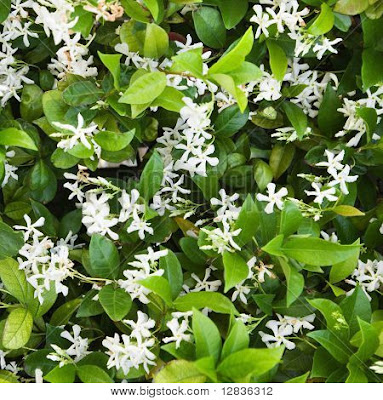Although not every jasmine produces fragrant flowers, the sweet scent of the ones that do is possibly what your memory recalls whenever you think of this plant.
Now weather you pick the bush or the vine is really a matter of what you like better. I think their both beautiful but I personally would go with the bush-I can always find room for a bush, but an arbor or something for a vine to grow up isn't as easy.
Either way I'll tell you all you need to know to grow them:
Instructions
1)Place your jasmine in full sun and out of low-lying areas, which trap cold air. While this plant tolerates light shade, it needs warmth.
2)Plant your jasmine shrub in a pot and take it out to the garden in the summer, unless you live in a tropical or subtropical climate. In that case, grow your jasmine outdoors year-round.
3)Space jasmine plants 8 feet apart in borders.
4)Irrigate your jasmine shrub from the bottom if it's in a pot. Place the planter in a deep tray of water and let the soil absorb the moisture through the drainage holes. Allow it to dry between watering.
5)Pinch off jasmine flower buds to encourage larger blooms and to control where the blossoms will appear.
6)Prune your jasmine plant throughout the year to control its growth and to keep it to the shape you want. In addition, cut branches that become entangled with one another just before spring growth begins.
7)Dilute some indoor plant fertilizer to half strength and mix 1 gallon of the mixture with 1 tablespoon of liquid kelp. Water your jasmine plant and allow the excess water to run out of the drainage holes, if planted in a pot. Feed it 2 cups of the fertilizing formula you prepared. Repeat this step once a month. When it begins to get cool in October, reduce applications to ½ cup of fertilizer a month.
8)Bring potted shrubs indoors in the fall before the first freeze. Place them in a well-lit and warm location during the day, but which also gets dark in the evening. Exposure to the day's sun promotes foliage and flower production throughout the winter while the evening darkness encourages the plant to make new buds.
9)Repot the jasmine shrub in late spring. By then, your plant should have grown enough to need a planter one size bigger. In preparation for transplanting it, reduce the water and stop fertilization in early spring. When the plant is in its new pot, mulch the soil surface with compost and prune long branches to induce a bushy habit. Move the plant outdoors for another summer.
Jasmine, the vine
Jasmine is a woody perennial vine grown outdoors in USDA Plant Hardiness Zones 8 through 10 and indoors in colder climates. Also known as Confederate Jasmine or by its scientific name of Trachelospermum jasminoides, the flowers have a pleasant jasmine fragrance and will grow on a fence or trellis.
Step 1
Locate the plants in full sun to partial shade if planted in the garden or in a container outdoors. The vine thrives indoors on indirect light throughout the summer but needs at least 4 hours of direct sunlight in the winter. Indoor plants can be placed outdoors in the summer, but don't place them in direct sun at first or they will burn.
Step 2
Water as soon the top of the soil feels dry during the spring and summer. Occasional misting should be done with distilled water when the air is particularly dry in the summer. In the fall, water the plant once every other week and cut back watering to once a month in the winter. Place indoor plants on a tray filled with pebbles and water. Do not allow the plant to sit directly in the water, just on top of the pebbles. This will provide the plant its required humidity.
Step 3
Apply a well-balanced fertilizer made for acid-loving plants once a month beginning in the spring. Discontinue fertilizing in mid-fall and begin again the following spring.
Step 4
Prune and thin straggly branches in the spring after blooming has finished to promote a bushier plant. In the winter, cut off any dead or diseased branches. Cut the plant back for shaping after the last frost. Do not cut more than 1/3 of the vine at any one time.
Until we meet again.....


3 comments:
Thank you for the tips! Hope you follow my garden adventures!
http://www.thegirlinthewildwest.com/
Hey fellow gardener, great tips!
Check out my latest blog here
http://mrsgardengirl.blogspot.com/2012/05/spring-has-sprung.html
I love your header- jealous of your garden!
Thanks for linking up on Weekend Blog Walk. I hope you can join us again this week! Now following you.
Jessica at @ Home Take 2
http://athometake2.blogspot.com
Post a Comment